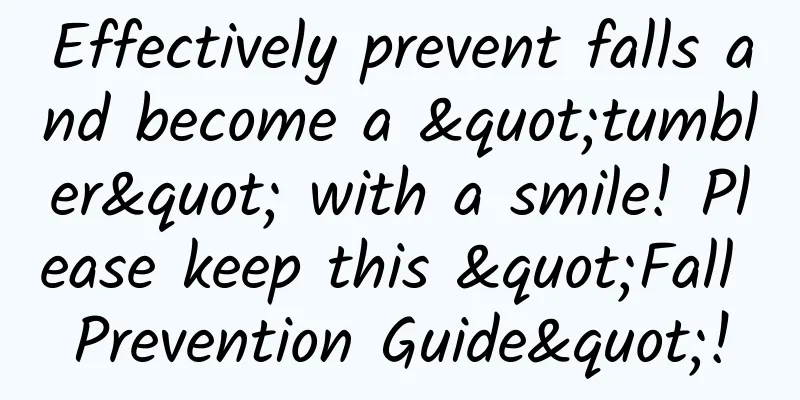Effectively prevent falls and become a "tumbler" with a smile! Please keep this "Fall Prevention Guide"!

|
Falling may seem like a trivial matter, but in serious cases it can lead to trauma, fractures, brain damage, or even death. In my country, falling has become the leading cause of accidental injuries among people over 65 years old, and for patients with diseases, falling is even worse. The muscles and bones that we once took pride in are not as tough as we thought and can be injured without warning. Falls are the leading cause of death from injuries among people aged 75 or above in my country, bringing a heavy economic and care burden to individuals, families and society. As the aging of the population in China continues, it is urgent to carry out fall risk assessment for the elderly and prevention of falls for the elderly at high risk. The following is some knowledge on fall prevention from the Department of Orthopedics of Jiangyong County People's Hospital . 1. Why-Why are the elderly prone to falls? 1. Decreased gait stability and impaired balance function are the main causes of falls in the elderly. As they age, degenerative changes occur in their bones, joints, ligaments and muscles, which can lead to impaired balance function and decline in muscle strength, thereby increasing the risk of falls. 2. Physical discomfort is related to the patient's disease state. Osteoporosis, osteoarthritis, Parkinson's disease, diabetes, hypertension and stroke are risk factors for falls. 3. Medication use in the elderly: Drugs that act on the cardiovascular system are mainly antihypertensive drugs, hypoglycemic drugs, such as insulin, psychotropic drugs, such as benzodiazepines, antianxiety drugs, sleeping pills, antidepressants, etc. Drugs are important and adjustable factors that cause falls. The type, dosage, and combination of drugs can increase the risk of falls. Strengthening the management of drugs that are prone to falls and taking active measures to prevent falls are extremely important in reducing the incidence of falls and the severity of injuries. 2. How to prevent falls during hospitalization? 1. Set up eye-catching signs for patients at high risk of falling An "anti-fall" warning is set at the head of each patient's bed to alert staff at all levels, patients and their families, so that doctors, nurses, caregivers, cleaning staff and family members in the ward can provide assistance or warnings when the patient is moving to prevent falls. 2. Take effective preventive measures for patients at high risk of falling (1) General measures: Strengthen patrols, promptly identify and meet patients' needs, secure the wheels of beds and wheelchairs, help patients choose appropriate exercise methods, teach patients how to use medications correctly, and inform them of reactions after taking medications. (2) Environmental prevention: Provide sufficient lighting, keep the floors of wards and bathrooms clean and dry, ensure that all bathroom hardware facilities and beds are intact, and secure the wheels of beds and bedside tables. 3. Strengthen health education for patients and their families (1) Keep passages clear (including public areas in the ward and the aisles beside the bed) and inform patients and their families that patients should not get out of bed and walk when the floor is slippery; (2) Check that the patient's clothing is of appropriate length and not too long, and that the patient is wearing non-slip shoes; (3) Introduce the location of the bedside call bell, teach patients how to use the bed rails, pay attention to the appropriate height of the bed, and prohibit leaning on the bedside table; (4) Introduce how to use the hardware facilities in the bathroom: keep the wash basin and floor dry; (5) Pay attention to the patient's daily living habits: whether the patient strains to defecate, causing increased intra-abdominal pressure and dizziness; do not dress on one foot after bathing to prevent falls due to imbalance; use a wiper to clean water on the ground in a timely manner to prevent slipping and falling, etc. 3. Focus on preventionFocus on mastering the three steps of getting up : lying down for 30 seconds - sitting up for 30 seconds - standing for 30 seconds. ➤Four steps to self-rescue after a fall 1. Fall down naturally without struggling, bend quickly and lower your center of gravity. 2. Seek possible help to put yourself in a prone position. 3. If there is no one around who can help you, take a short rest, recover some strength, and then call for help. 4. After falling, do not rush to get up if you are sure the environment is safe, to prevent secondary injuries. First, judge the extent of the injury through physical sensation and slight movements. If the injury after the fall is serious, you should try to maintain the original position, ask for help from people around you or call the emergency number, and wait for rescue; if the environment where you fell is not safe enough, you should still try to move to a safe area. The above is the fall prevention knowledge summarized for everyone. By formulating sustainable fall prevention guidelines, the risk of falls can be eliminated in the bud, the occurrence of falls can be reduced, and life safety can be ensured. The road to preventing falls is long and arduous. The Department of Orthopedics of Jiangyong County People's Hospital hopes that everyone can walk steadily on the journey of life, stay away from the trouble of falling, embrace every moment of health and vitality, measure the years with firm steps, and write a chapter of safe and beautiful life. Hunan Medical Chat Special Author: Liu Qiao from Jiangyong County People’s Hospital Follow @湖南医聊 to get more health science information! (Edited by YT) |
<<: Demystifying stomach acid: Its dual role in stomach health
>>: Flat foot series popular science --- the harm of flat feet
Recommend
Lying flat on the back with hard bulge in lower abdomen
Uterine fibroids have become a common gynecologic...
Can pregnant women use mouthwash?
In fact, this can easily lead to various problems...
There is a painless lump under the breast
Breasts are the most important secondary sexual c...
Can medical abortion lead to clean abortion?
Medical abortion can be clean, but you need to pa...
How long does artificial insemination take?
Artificial insemination refers to the combination...
Pregnant woman lying down with hard stomach
In fact, when pregnant, women will pay close atte...
What to do if girls have smelly feet in the dormitory
Compared with boys, girls are more concerned abou...
Why is there a little blood in the vaginal discharge?
As girls, we all have some troubles, and some are...
Picture of gestational sac around 40 days
The creation of life is a wonderful process. The ...
Is your corneal thickness suitable for myopia surgery?
Corneal thickness is one of the important indicat...
What is the reason for postpartum urination?
After giving birth, you still feel like urinating...
What are the symptoms of 42 days of pregnancy?
Pregnancy is a necessary process for every family...
The liver doesn't speak, but it controls the spots on your face!
As the saying goes: "The stomach is a trumpe...
What is vaginitis?
The vagina is a reproductive organ unique to wome...
How effective is microwave therapy for cervicitis?
The so-called cervicitis is actually cervical ero...









